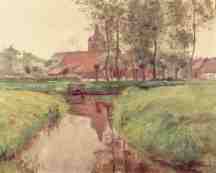The value and meaning of these “landscapes” is determined by two remarkable features: the graphical accuracy and the character of the coloration. To be added is the poetic exaltation for the majesty of the South-Flemisch Ardennes, with the surroundings of Geraardsbergen as the main centre.
In the way the artist transforms the external happening to an impeccable beauty of form, we recognize in this unprejudiced and unconstrained calligraphic display a talent of which only Jan De Cooman knew the secret.
His coloration is one of repentance and of seriousness, free of bravura and buoyancy. The artist familiarizes with a characteristic of simplicity, modesty and veracity that we admire so much in the Englishman, John Constable, and in the masters of the School of Barbizon and that was also adopted by our own Flemish realistic painters, Hippoliet Boulenger, Isidoor Verheyden, Theo Verstraeten, Frans Courtens and others. Especially in his very fine and tender works, finished on the spot, the stilistic aspects of Jan De Cooman share with our great realistic painters, that they never express any violence or eagerness, but they express what they have to say with a tangible devotion.
There is nothing is his technique that indicates any fluttering or insincerity, or that is obfuscated by dry archaism. The style remains linked to calm, serenity and clearness as the expression of the inner emotional condition of the artist.
The landscapes of Jan De Cooman are poetic evocations of the land of Geraardsbergen. The simple rustic beauty is for the painter a symbol and an ideal of which he sees the essence in a concrete way. He tells us how the seasons and the turning of the hours continuously transmogrify the land into a new fairy tale. He tells us how the trees whisper to each other, how the winds make music, how the clouds rise as mighty smoulders of incense into the spacious temple of nature, how the descending hills uncover in the blue haze. He opens this very own feature of the land of Zandbergen, the present devotion, the kindheartedness and joy that hover around, so complete and unisono with the cristal fragility of its own being. Jan De Cooman is the subtle poet of this most beautiful land that flows out into distant horizons.
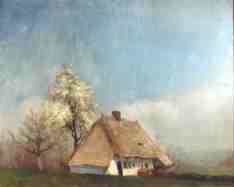 “The Flourishing Pear-tree”, in three variants, each time different and each time just as fresh of feeling and with a delicate key, is seen by us as the convincing manifestation of his sedate technical mastery, high-minded on a pure poetic emotion. A straw dump and next to it a flourishing pear-tree: nothing more, a most paltry gift of nature!
“The Flourishing Pear-tree”, in three variants, each time different and each time just as fresh of feeling and with a delicate key, is seen by us as the convincing manifestation of his sedate technical mastery, high-minded on a pure poetic emotion. A straw dump and next to it a flourishing pear-tree: nothing more, a most paltry gift of nature!
But how is it done? With what skilfulness of hand and with what power of vision? The atmospheric coherence is blue, velvety, soft fluent blue and within it the melodious modulation of white, very pure white and very soft: ivory white in the grandiose bouquet of the flourishing tree, a milkwhite spot projected on the limed wall by the light, cream white in the colouring of the horizon. Wasn’t it about the Flourishing Pear-tree that a French art critic blissfully wrote: “C’est une merveille”? This canvas is indeed a wonder of delicate sensoriality and of just as finely strung sensitivity. It’s an ordened composition, loose of superficiality and free of flattery. It’s delicate as a poem of Guido Gezelle.
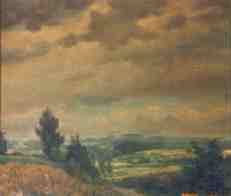 Very remarkable are the large summer landscapes “Onkerzele”. Jan De Cooman has treated this theme up to ten times. And each time he confirmed his skill in another way. Behind the woods of Onkerzele is the Land of Geraardsbergen, uncovered as a panoramic revelation: immense and unmoved, a see of green, a blue infinity in distant horizons.
Very remarkable are the large summer landscapes “Onkerzele”. Jan De Cooman has treated this theme up to ten times. And each time he confirmed his skill in another way. Behind the woods of Onkerzele is the Land of Geraardsbergen, uncovered as a panoramic revelation: immense and unmoved, a see of green, a blue infinity in distant horizons.
This spacious showing, that Breugel turned into a feast for the eye in his mighty nature scenes, Jan De Cooman brings it to us in its unspoiled lifelike majesty. Herein lays his vision and interpretation, an unavoidable impressionistic sensitivity locates the instant omnipotence of the subject with a spontaneous directness and accuracy.
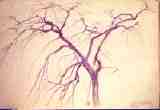 In all paintings of Jan De Cooman his weakness for trees comes to the front. Their immense majesty touches the painter deeply. It’s understandable that he, a gifted drawer par excellence, takes delight in the freakish tangle of branches and twigs of tall trees and aged knotty pollard-willows.
In all paintings of Jan De Cooman his weakness for trees comes to the front. Their immense majesty touches the painter deeply. It’s understandable that he, a gifted drawer par excellence, takes delight in the freakish tangle of branches and twigs of tall trees and aged knotty pollard-willows.
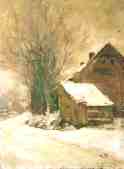 He loved dealing with the motif of snow. In the winter of 1939-1940 the fairy tale of snow lasted for months and the artist could paint the snowy sceneries, from within his heated car, to his heart’s content. The pictures from then spread a masterful originality in the representation of the tender, blank softness on the verge, in the delicate materialisation of the endless, sad, desconsolate spaciousness, in which sounds are hushed and black trees groan of loneliness under a sky filled with fresh bunches of snow. The snowy scenery immerses in an atmosphere of cristalline silence.
He loved dealing with the motif of snow. In the winter of 1939-1940 the fairy tale of snow lasted for months and the artist could paint the snowy sceneries, from within his heated car, to his heart’s content. The pictures from then spread a masterful originality in the representation of the tender, blank softness on the verge, in the delicate materialisation of the endless, sad, desconsolate spaciousness, in which sounds are hushed and black trees groan of loneliness under a sky filled with fresh bunches of snow. The snowy scenery immerses in an atmosphere of cristalline silence.
It’s remarkable that the human figure acts only very rarely in his landscapes. We know only one painting, “Harvest Land”, with a cartload on the foreground, pulled by two cows, and the farmer with his hand on the adze.
About the little interest for the human figure in his landscapes, the artist stated:
“The landscape, that is land and clouds, stump and tree, corn cocks and sandy roads. That is to me as a spot of Paradise, the park in which the Lord makes his daily walk. When I paint a landscape, a feeling of humility, respect and awe enters me. I feel the presence of the Boss from upstairs. Nature is to me a sanctuary, born in the hour of Creation. It remained and will remain for ever unchanged and untouched, because its beauty is eternal. Why disfigure this endless resplendence with freaky human figures that mark the time, where in reality, time doesn’t exist? I have enough with sky and clouds, with branches and leafs, with the produce of the fields and green meadows and, above all, with the magical colorchanges all over. Whenever I paint nature, I have to feel her, sense her and taste her. When my senses are filled by her pleasures, I poor it all out in colours and lines, exactly as it is in me. No, Our Lord and nature belong to each other, that’s what I feel when I paint nature.”
![]()
